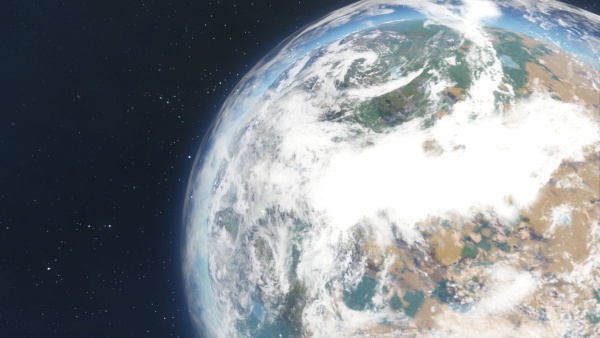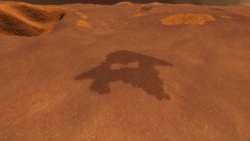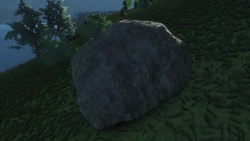Planet

Contents
Overview
Planets are destructible voxel objects with their own Gravity field, atmosphere, vegetation, and hostile life. They are similar to Asteroids in that they're fully destructible voxels, and have randomly generated Ores but that's where their similarities end. Planets range in size from 19km to 120km in diameter. By default, each planet comes with it's own accompanied Moon, unless manually spawned in by a player. Moons and Planets are exactly the same objects technically and are very similar in practice, with a few key differences being: Moons are much smaller often only 38km in diameter and possess much weaker gravitational fields - down to 0.25 g.
Much like Asteroids they are completely immobile and never will move no matter how much force is applied, and are themselves not in anyway affected by gravity. If two planets were spawned very close to each other inside both of their gravitational fields, niether of them would ever fall into each other and meet. Although objects would experience some very strange gravitational effects from both of them.
Surface Generation
While their surface appears randomly generated, they're in fact pre-loaded voxel models. There is no procedural generation with Planets or Moons. When the size of the Planet is increased, it actually stretches the models to accommodate for the new size. The textures and vegetation aren't stretched, only the surface model is. Each planet type Earth, Mars, and Alien will spawn the appropriate models and surface textures associated with them. The same properties are applied even when it is spawned in manually by the player via (default) - SHIFT+F10 in Creative Mode.
Ore Generation
| |
|
|
|
|
|
|
|
|
|
|
| Cobalt Ore | Gold Ore | Ice | Iron Ore | Magnesium Ore | Nickel Ore | Platinum Ore | Silicon Ore | Silver Ore | Stone | Uranium Ore |
| Yes | Yes | Yes | Yes | Yes | Yes | No | Yes | Yes | Yes | No |
Surface
(~15 to ~50 Meters):
Large horizontal veins of Ores with a thickness of a few meters. Each ore patch usually contains 1-4 ores. Different ores of the same patch can be found in different height levels.
The surface above the ore patches is slightly darker and in a brown-ish color, so they can be easily spotted from a higher position. Dense Grass can make spotting harder. All ice lakes on the surface of a planet contain Ice ores, despite looking like flowing water.
Boulders
The ore is hidden inside stone rocks that are spread randomly over the surface. Boulders are all about the same size, they contain about ~20,000 of rare ores up to ~100,000 of iron ore. Under certain conditions, the positions of non-drilled boulders are reset completely, so GPS-Markers on these rocks become void. The rocks are also voxel entities that are separate from the planets voxels. They do overlap the planet in the way that station blocks do.
Atmosphere
Different planets have different atmosphere densities. All thrusters behave differently in a planets atmosphere[1], with an exception to Hydrogen Thrusters. Ion Thrusters become less effective in dense thick atmospheres conversely Atmospheric Thrusters increase in effectiveness the more dense the atmosphere is. To not working at all without any planetary atmosphere present, while Ion Thrusters still can operate inside a thick atmosphere but only at 30% of their power (being 100% effective outside of planetary atmospheres). Some planets do not possess atmospheres at all (such as certain Moons) or have only very thin atmospheres, there Ion Thrusters are less affected conversely atmospheric thrusters are much less useful or not all useful.
Ion Thrusters
Ion Thrusters (Large Thruster), vary linearly in effectiveness from a minimum of 30% near the surface of a planet with a thick atmosphere to full 100% effectiveness out of it. Planets or Moons entirely without atmospheres will have Ion Thrusters operate at full effectiveness.
e = effectiveness of Ion Thruster as a percentage
r = current altitude/distance from the core of the planet in meters
R = radius of the planet in meters
A = 'LimitAltitude' effectively defining the height of the atmosphere.
H = The 'Hills' Parameter - it's found in the planet's sbc file,
it loosely correlates to the maximum height of any mountain/hill as a ratio.
Typically this is exactly '0.12'.
(r - R)
e = ( ------------ ) x 0.7 + 0.3
(R x H x A)
Atmospheric Thrusters
Atmospheric Thrusters act almost inversely with Ion Thrusters, while thick atmospheres are disadvantageous to Ion Thrusters - they are advantageous to Atmospheric Thrusters. They operate anywhere 100% at the planet's radius otherwise known as 'the surface' to 0% effectiveness (providing no lift or propulsion) when they leave the atmosphere of the planet. They require an planetary atmosphere to operate, whether breathable or not - pressurized rooms will not do.
e = effectiveness of Atmospheric Thruster as a percentage
r = current altitude/distance from the core of the planet in meters
R = radius of the planet in meters
A = 'LimitAltitude' effectively defining the height of the atmosphere, typically 2.0
H = The 'Hills' Parameter - it's found in the planet's sbc file,
it loosely correlates to the maximum height of any mountain/hill as a ratio.
Typically this is exactly '0.12'.
(r - R)
e = 1 - ( ----------------- )
R x 0.7 x H x A
Gravitational Field
Planets generally have 1 g of acceleration (9.81 m/s^2), while Moons have 0.25 g (2.45 m/s^2). They remain constant within a certain range but quickly diminish beyond a certain point, generally it's highest peak at an exponential rate. Once the gravity of the planet or moon (in units of g), reaches 0.05 g anything beyond this range is no longer affected by the planet's gravity and has completely escaped it's gravitational influence. This distance is much shorter than in reality for actual planets, making actual high altitude low-speed orbits impossible - although it is possible to park a station or ship in place at this point to act as if it were in Geosynchronous orbit. The effective range of a planet's gravitational field extends out approximately 71.82% of the radius of the planet, starting out from it's surface and decreasing exponentially after it's 'Hills Parameter attitude'. For example, a planet with a radius of 10km - will have it's gravitational influence extend out to 17.18 km from it's center.[2]
Gravity Generators (Gravity Generator, Spherical Gravity Generator) and Jump drives are negatively affected by the presence of natural gravity from planets and moons, which for Jump Drives renders them completely inoperable - the presence of any Natural Gravity that is sufficiently detectable (greater than 0.05 g) cannot be 'jumped' into or out of. Gravity Generators will still operate in natural gravity but at increasingly reduced effectiveness the stronger the natural gravity becomes.
The following formulas describe the gravity of planets/moons:
g = the current acceleration due to gravity felt at r (the current altitude away from the core) in m/s^2 (on the surface it should be 9.81 m/s^2 or 1 g) b = base g in m/s^2. For planets: 9.81. For moons: 2.45 m/s^2 (a quarter of 9.81 or 0.25 g) r = current altitude/distance from planet 'center' or core in meters. MinR = the minimum Radius of the planet in meters - it's found in the planet's sbc file. MaxR = the maximum Radius of the planet in meters - it's found in the planet's sbc file, if r > MaxR g = b x (MaxR/r )^7 [Gravity after maximum Radius decreases exponentially to the power of 7] if MinR <= r <= MaxR g = b [Gravity remains base g until, your distance from planet 'center' is greater than the maximum Radius] if r < MinR g = b x (r/MinR) [Typically radius less than minimum Radius under the 'surface' of the planet]
Hazards
Pirate Bases
Currently only present on:
Pirate Bases are hostile structures under the Ownership of the Pirate faction. They will periodically spawn hostile ships to attack the player(s) at any given location, and will keep doing so until they or the player is completely destroyed.
The pirate bases are not randomly generated, but instead were placed manually into the world. Each Planet has a set number of these bases, and on it's accompanied Moon for the player(s) to add more challenge/difficulty.
NPCs
Planets are home to NPC's, that will make building or operating on a Planet much more challenging or interesting. Their aggressiveness, spawn timers, and numbers range differ from each other. The engineers location does not matter, they will spawn in any environment on the Planet surface. Listed below are the NPC's in the game:
| NPC | Location | State | Drops Items? | Spawn Radius | Spawn Conditions | Frequency |
| Sabiroid | Alien (Planet) Titan (Moon) | Hostile | Yes | 3-10m |
None | 15-45 Minutes
|
| Cyberhound | Earth (Planet) | Hostile | Yes | 500-1000m |
Night | 15-45 Minutes
|
Planet Variants
<Explanation of planets having different types>
There are three types of planets, as follows:
Earth-Like
The Earth planet variation represents a scaled down version of the real-life Earth. It has similar plants, and some of the environments. It has a breathable atmosphere, and a default Gravity of 1g.
Mars
The Mars planet variation represents a scaled down version of the real-life Mars. It's a barren planet with no vegetation of any kind. It has a default Gravity of 0.9g, but does not have a breathable atmosphere.
Alien
The Alien planet variation is a fictional planet with a unique set of properties and strange vegetation. It has a default Gravity of 1.10g, and has a thin breathable atmosphere, but just barely.
Pertam
The Pertam planet variation is a fictional hot desert planet that is mostly flat and is popular for rover racing. It has a default Gravity of 1.2g, and has a breathable atmosphere in lower regions.
Triton
The Triton planet variation is a fictional cold snow planet with no signs of life, where ice is abundant. It has a default Gravity of 1.0g, and has a breathable atmosphere in lower regions. It's part of the Frostbite DLC and the default Star System Scenario.
| Planet Name | Atmosphere | Oxygen | Gravity | Radius | Gravity Well (Meters from Sea Level) | Troposphere (Atmospheric Engine Limit Altitude |
| Earth | Yes | Yes | 1g | 60km | 45,000 | 10080 |
| Alien | Yes | Barely | 1.1g | 60km | 45,000 | 10080 |
| Mars | Yes | No | .9g | 60km | 45,000 | 10080 |
| Pertam | Yes | Yes | 1.2g | ~30km | 22,550 | 1052 |
| Triton | Yes | Yes | 1g | ~40km | 30,095 | 2640 |
See Also
Known Issues
Update History
| Update 01.108 |
|

